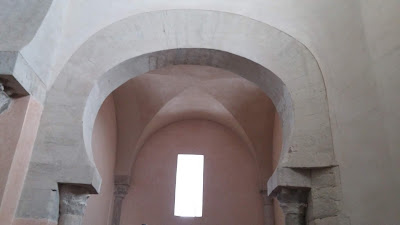 |
| The side of San Cebrián where you can best see the mozarabic contours All photos in this post 2018 Jessica Knauss unless otherwise indicated. |
 |
| No amount of camouflage can hide this building's ancientness! |
 |
| Beautifully restored ceiling Photo 2018 José Pablo Palencia Morchón |
San Cebrián is the largest and best preserved church of this style and time period.
Although the seventeenth-century bell gable as you head toward the church is not promising, when the man comes with the keys to let you, your companion, and more weekend medievalists than you expected inside, all your hopes for a tenth-century experience are immediately satisfied.
You're surrounded by horseshoe arches that divide the space into three naves.
Each column and its capital (most Corinthian in design) was culled from former Roman buildings to be recycled here. All the capitals are unique, with no repeats. While the tenth-century arches are flawlessly uniform, the capitals and columns come up to slightly different heights, punctuating their uniqueness.
 |
| Photos 2018 José Pablo Palencia Morchón |
Other tenth-century delights include a separate horseshoe arch obviously inspired by Córdoba...
and a lintel found during archaeological excavations. Again, I love the alien feel of pre-Romanesque carving.
 |
| The right side chapel has an original mozarabic ceiling, but like the left side chapel, its shape doesn't quite achieve a horseshoe. |
 |
| The left side chapel archway |
The mozarabic aesthetic, like the Visigothic one, called for secretive ceremonies cut off from the congregation. It didn't matter, in fact it was preferable, if the opening to the altar was too small for anyone in the peanut gallery to get a view. In just a few hundred years, this policy was reviewed, and probably by the twelfth century--that universal medieval style, Romanesque--new architects and craftsmen with new ideas wanted to widen the arches that opened onto the main altar and chapels. They inserted a few more bricks into the horseshoe arches and moved the columns, a process that made it impossible to preserve the integrity of the original design.
I think the same process happened in Wamba.
Outside, this filled-in horseshoe arch is more evidence of changes in the way the building was used over time.
This sixteenth-century alabaster Virgin of the Assumption by Inocencio Burruguete probably came from the nearby Monastery of the Holy Thorn, where they now have a replica.
 |
| Photo 2018 José Pablo Palencia Morchón |
 |
| The foot of the church has a display about the modern architectural discovery of the building. |
 |
| Photo 2018 José Pablo Palencia Morchón |
Now I see the sense in wintertime tourism. At least you can warm up afterward, maybe have a tea or hot chocolate, while in the summer, it's hard to enjoy anything under pounding sunlight close to 100 degrees when you don't have air conditioning back home! Don't be surprised if I lie low and ride out the summer, writing blogs about all the amazing things I saw this winter.










No comments:
Post a Comment